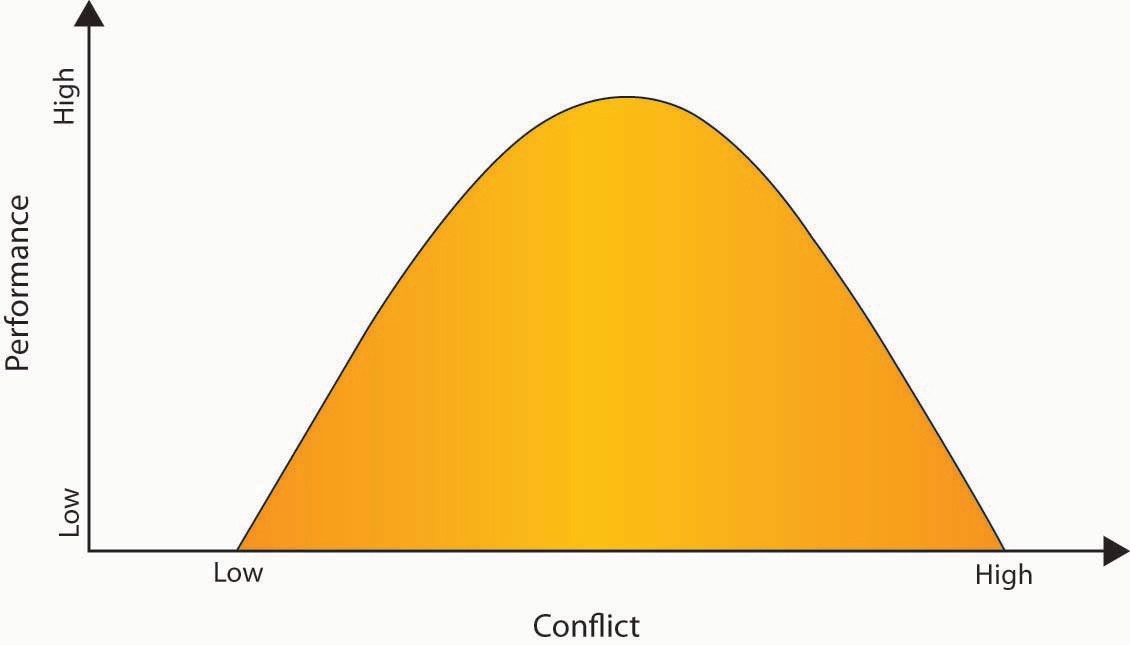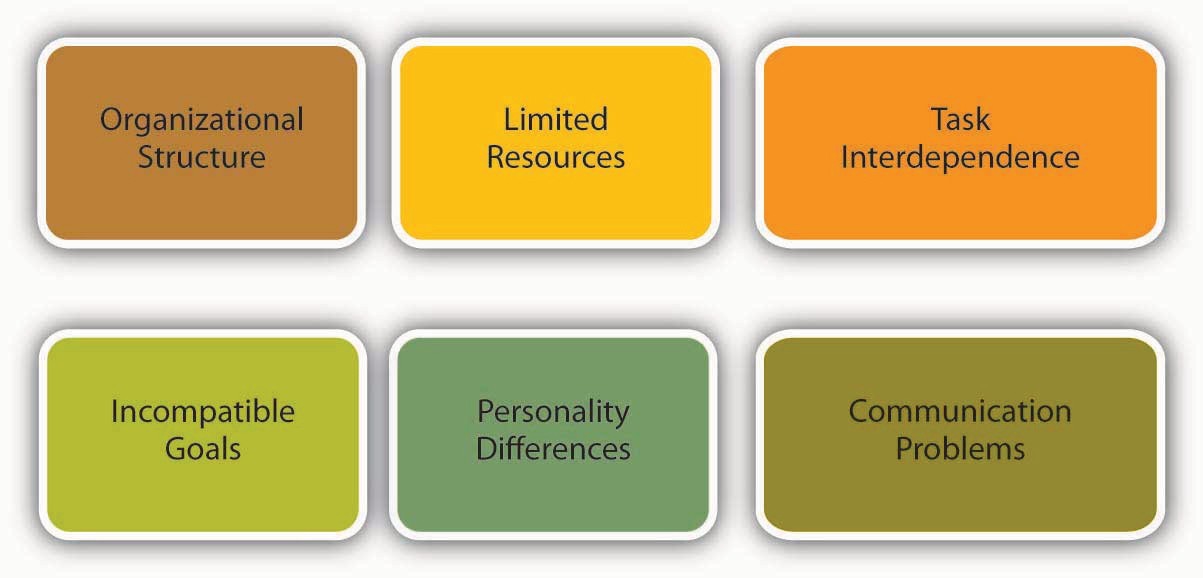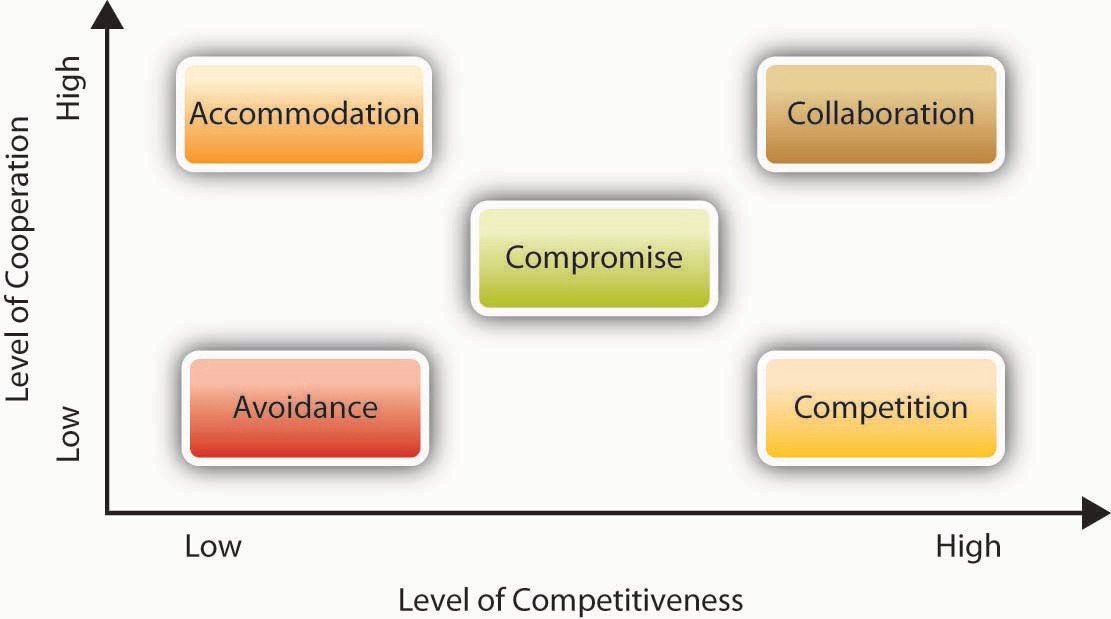6.1 Understanding Conflict
Let’s take a closer look at these social issues such as conflict to understand how they can derail companies and individuals alike—and what to do to prevent such consequences from happening to you. In this chapter, you’ll see that managing conflict and engaging in effective negotiation are both key for effective organizational behaviour within organizations as well as daily life. Conflicts range from minor annoyances to outright violence. For example, one million workers (18,000 people per week) are assaulted on the job in the United States alone (National Institute for Occupational Safety and Health, 1997). One of the major ways to avoid conflicts escalating to these levels is through understanding the causes of conflict and developing methods for managing potential negative outcomes. Negotiation is one of the most effective ways to decrease conflict and will also be examined in depth in this chapter.
Similar to how conflicts can range from minor to major, negotiations vary in terms of their consequences. A high-stakes negotiation at work might mean the difference between a company’s survival and its demise. On the other end of the spectrum, we deal with minor negotiations on a regular basis, such as negotiating with a coworker about which movie to see. Maybe you make a concession: “OK, we’ll watch what you want but I get to pick where we eat.” Maybe you hold tough: “I don’t want to watch anything except a comedy.” Perhaps you even look for a third option that would mutually satisfy both parties. Regardless of the level, conflict management and negotiation tactics are important skills that can be learned. First, let’s take a deeper look at conflict.
Conflict is a process that involves people disagreeing. Researchers have noted that conflict is like the common cold. Everyone knows what it is, but understanding its causes and how to treat it is much more challenging (Wall & Callister, 1995). As we noted earlier, conflict can range from minor disagreements to workplace violence. In addition, there are three types of conflict that can arise within organizations. Let’s take a look at each of them in turn.
Types of Conflict
Intrapersonal Conflict
Intrapersonal conflict arises within a person. For example, when you’re uncertain about what is expected or wanted, or you have a sense of being inadequate to perform a task, you are experiencing intrapersonal conflict. Intrapersonal conflict can arise because of differences in roles. A manager may want to oversee a subordinate’s work, believing that such oversight is a necessary part of the job. The subordinate, on the other hand, may consider such extensive oversight to be micromanagement or evidence of a lack of trust. Role conflict, another type of intrapersonal conflict, includes having two different job descriptions that seem mutually exclusive. This type of conflict can arise if you’re the head of one team but also a member of another team. A third type of intrapersonal conflict involves role ambiguity. Perhaps you’ve been given the task of finding a trainer for a company’s business writing training program. You may feel unsure about what kind of person to hire—a well-known but expensive trainer or a local, unknown but low-priced trainer. If you haven’t been given guidelines about what’s expected, you may be wrestling with several options.
Interpersonal Conflict
Interpersonal conflict happens between individuals such as coworkers, managers, or CEOs and their staff. For example, in 2006 the CEO of Airbus S.A.S., Christian Streiff, resigned because of his conflict with the board of directors over issues such as how to restructure the company (Michaels, Power, & Gauthier-Villars, 2006). This example may reflect a well-known trend among CEOs. According to one estimate, 31.9% of CEOs resigned from their jobs because they had conflict with the board of directors (Whitehouse, 2008). CEOs of competing companies might also have public conflicts. In 1997, Michael Dell was asked what he would do about Apple Computer. “What would I do? I’d shut it down and give the money back to shareholders.” Ten years later, Steve Jobs, the CEO of Apple Inc., indicated he had clearly held a grudge as he shot back at Dell in an e-mail to his employees, stating, “Team, it turned out Michael Dell wasn’t perfect in predicting the future. Based on today’s stock market close, Apple is worth more than Dell” (Haddad, 2001; Markoff, 2006). In part, their long-time disagreements stem from their differences. Interpersonal conflict often arises because of competition, as the Dell/Apple example shows, or because of personality or value differences. For example, one person’s style may be to “go with the gut” on decisions, while another person wants to make decisions based on facts. Those differences will lead to conflict if the individuals reach different conclusions. Many companies suffer because of interpersonal conflicts. Keeping conflicts centered around ideas rather than individual differences is important in avoiding a conflict escalation.
Intergroup Conflict

Intergroup conflict takes place among different groups. Types of groups may include different departments or divisions in a company, and employee union and management, or competing companies that supply the same customers. Departments may conflict over budget allocations; unions and management may disagree over work rules; suppliers may conflict with each other on the quality of parts. Merging two groups together can lead to friction between the groups—especially if there are scarce resources to be divided among the group. For example, in what has been called “the most difficult and hard-fought labour issue in an airline merger,” Canadian Air and Air Canada pilots were locked into years of personal and legal conflict when the two airlines’ seniority lists were combined following the merger (Stoykewych, 2003). Seniority is a valuable and scarce resource for pilots, because it helps to determine who flies the newest and biggest planes, who receives the best flight routes, and who is paid the most. In response to the loss of seniority, former Canadian Air pilots picketed at shareholder meetings, threatened to call in sick, and had ongoing conflicts with pilots from Air Canada. The conflicts with pilots continue to this day. The history of past conflicts among organizations and employees makes new deals challenging.
Is Conflict Always Bad?
Most people are uncomfortable with conflict, but is conflict always bad? Conflict can be dysfunctional if it paralyzes an organization, leads to less than optimal performance, or, in the worst case, leads to workplace violence. Surprisingly, a moderate amount of conflict can actually be a healthy (and necessary) part of organizational life (Amason, 1996). To understand how to get to a positive level of conflict, we need to understand its root causes, consequences, and tools to help manage it. The impact of too much or too little conflict can disrupt performance. If conflict is too low, then performance is low. If conflict is too high, then performance also tends to be low. The goal is to hold conflict levels in the middle of this range. While it might seem strange to want a particular level of conflict, a medium level of task-related conflict is often viewed as optimal, because it represents a situation in which a healthy debate of ideas takes place.

Key Takeaways
Conflict can be a problem for individuals and organisations. There are several different types of conflict, including intrapersonal, interpersonal, and intergroup conflict. Moderate conflict can be a healthy and necessary part of organisational life.
Task conflict can be good in certain circumstances, such as in the early stages of decision making, because it stimulates creativity. However, it can interfere with complex tasks in the long run (De Dreu & Weingart, 2003). Personal conflicts, such as personal attacks, are never healthy because they cause stress and distress, which undermines performance. The worst cases of personal conflicts can lead to workplace bullying. At Intel Corporation, all new employees go through a 4-hour training module to learn “constructive confrontation.” The content of the training program includes dealing with others in a positive manner, using facts rather than opinion to persuade others, and focusing on the problem at hand rather than the people involved. “We don’t spend time being defensive or taking things personally. We cut through all of that and get to the issues,” notes a trainer from Intel University (Dahle, 2001). The success of the training remains unclear, but the presence of this program indicates that Intel understands the potentially positive effect of a moderate level of conflict. Research focusing on effective teams across time found that they were characterized by low but increasing levels of process conflict (how do we get things done?), low levels of relationship conflict with a rise toward the end of the project (personal disagreements among team members), and moderate levels of task conflict in the middle of the task time line (Jehn & Mannix, 2001).
Exercises
- What are the types of conflicts that individuals may have at work? Which type have you experienced the most?
- What are some primary causes of conflict at work?
- Explain how miscommunication might be related to a conflict at work.
Causes and Outcomes of Conflict
There are many potential root causes of conflict at work. We’ll go over six of them here. Remember, anything that leads to a disagreement can be a cause of conflict. Although conflict is common to organizations, some organizations have more than others.

Organization Structure
Conflict tends to take different forms, depending upon the organizational structure (Jaffe, 2000). For example, if a company uses a matrix structure as its organizational form, it will have decisional conflict built in, because the structure specifies that each manager report to two bosses. For example, global company ABB Inc. is organized around a matrix structure based on the dimensions of country and industry. This structure can lead to confusion as the company is divided geographically into 1,200 different units and by industry into 50 different units (Taylor, 1991).
Limited Resources
Resources such as money, time, and equipment are often scarce. Competition among people or departments for limited resources is a frequent cause for conflict. For example, cutting-edge laptops and gadgets such as a BlackBerry or iPhone are expensive resources that may be allocated to employees on a need-to-have basis in some companies. When a group of employees have access to such resources while others do not, conflict may arise among employees or between employees and management. While technical employees may feel that these devices are crucial to their productivity, employees with customer contact such as sales representatives may make the point that these devices are important for them to make a good impression to clients. Because important resources are often limited, this is one source of conflict many companies have to live with.
Task Interdependence
Another cause of conflict is task interdependence; that is, when accomplishment of your goal requires reliance on others to perform their tasks. For example, if you’re tasked with creating advertising for your product, you’re dependent on the creative team to design the words and layout, the photographer or videographer to create the visuals, the media buyer to purchase the advertising space, and so on. The completion of your goal (airing or publishing your ad) is dependent on others.
Incompatible Goals
Sometimes conflict arises when two parties think that their goals are mutually exclusive. Within an organization, incompatible goals often arise because of the different ways department managers are compensated. For example, a sales manager’s bonus may be tied to how many sales are made for the company. As a result, the individual might be tempted to offer customers “freebies” such as expedited delivery in order to make the sale. In contrast, a transportation manager’s compensation may be based on how much money the company saves on transit. In this case, the goal might be to eliminate expedited delivery because it adds expense. The two will butt heads until the company resolves the conflict by changing the compensation scheme. For example, if the company assigns the bonus based on profitability of a sale, not just the dollar amount, the cost of the expediting would be subtracted from the value of the sale. It might still make sense to expedite the order if the sale is large enough, in which case both parties would support it. On the other hand, if the expediting negates the value of the sale, neither party would be in favor of the added expense.
Personality Differences
Personality differences among coworkers are common. By understanding some fundamental differences among the way people think and act, we can better understand how others see the world. Knowing that these differences are natural and normal let’s anticipate and mitigate interpersonal conflict—it’s often not about “you” but simply a different way of seeing and behaving. For example, Type A individuals have been found to have more conflicts with their coworkers than Type B individuals (Baron, 1989).
Communication Problems
Sometimes conflict arises simply out of a small, unintentional communication problem, such as lost emails or dealing with people who don’t return phone calls. Giving feedback is also a case in which the best intentions can quickly escalate into a conflict situation. When communicating, be sure to focus on behaviour and its effects, not on the person. For example, say that Jeff always arrives late to all your meetings. You think he has a bad attitude, but you don’t really know what Jeff’s attitude is. You do know, however, the effect that Jeff’s behaviour has on you. You could say, “Jeff, when you come late to the meeting, I feel like my time is wasted.” Jeff can’t argue with that statement, because it is a fact of the impact of his behaviour on you. It’s indisputable, because it is your reality. What Jeff can say is that he did not intend such an effect, and then you can have a discussion regarding the behaviour.
Outcomes of Conflict
One of the most common outcomes of conflict is that it upsets parties in the short run (Bergman & Volkema, 1989). However, conflict can have both positive and negative outcomes. On the positive side, conflict can result in greater creativity or better decisions. For example, as a result of a disagreement over a policy, a manager may learn from an employee that newer technologies help solve problems in an unanticipated new way.
Positive outcomes include the following:
- Consideration of a broader range of ideas, resulting in a better, stronger idea
- Surfacing of assumptions that may be inaccurate
- Increased participation and creativity
- Clarification of individual views that build learning
On the other hand, conflict can be dysfunctional if it is excessive or involves personal attacks or underhanded tactics.
Examples of negative outcomes include the following:
- Increased stress and anxiety among individuals, which decreases productivity and satisfaction
- Feelings of being defeated and demeaned, which lowers individuals’ morale and may increase turnover
- A climate of mistrust, which hinders the teamwork and cooperation necessary to get work done
Given these negative outcomes, how can conflict be managed so that it does not become dysfunctional or even dangerous? We’ll explore this in the next section.
Key Takeaways
Conflict has many causes, including organisational structures, limitations on resources, task interdependence, goal incompatibility, personality differences, and communication challenges.
Outcomes of well-managed conflict include increased participation and creativity, while negatives of poorly managed conflict include increased stress and anxiety. Jobs that deal with people are at higher risk for conflict.
Exercises
- What are some primary causes of conflict at work?
- What are the outcomes of workplace conflict? Which types of jobs are the most at risk for workplace violence? Why do you think that is?
- What outcomes have you observed from conflict?
Conflict Management
There are a number of different ways of managing organizational conflict, which are highlighted in this section. Conflict management refers to resolving disagreements effectively.
Ways to Manage Conflict
Change the Structure
When structure is a cause of dysfunctional conflict, structural change can be the solution to resolving the conflict. Consider this situation. Vanessa, the lead engineer in charge of new product development, has submitted her components list to Tom, the procurement officer, for purchasing. Tom, as usual, has rejected two of the key components, refusing the expenditure on the purchase. Vanessa is furious, saying, “Every time I give you a request to buy a new part, you fight me on it. Why can’t you ever trust my judgment and honour my request?”
Tom counters, “You’re always choosing the newest, leading-edge parts—they’re hard to find and expensive to purchase. I’m supposed to keep costs down, and your requests always break my budget.”
“But when you don’t order the parts we need for a new product, you delay the whole project,” Vanessa says.
Sharon, the business unit’s vice president, hits upon a structural solution by stating, “From now on, both of you will be evaluated on the total cost and the overall performance of the product. You need to work together to keep component costs low while minimizing quality issues later on.” If the conflict is at an intergroup level, such as between two departments, a structural solution could be to have those two departments report to the same executive, who could align their previously incompatible goals.
Change the Composition of the Team
If the conflict is between team members, the easiest solution may be to change the composition of the team, separating the personalities that were at odds. In instances in which conflict is attributed to the widely different styles, values, and preferences of a small number of members, replacing some of these members may resolve the problem. If that’s not possible because everyone’s skills are needed on the team and substitutes aren’t available, consider a physical layout solution. Research has shown that when known antagonists are seated directly across from each other, the amount of conflict increases. However, when they are seated side by side, the conflict tends to decrease (Gordon et al., 1990).
Create a Common Opposing Force
Group conflict within an organization can be mitigated by focusing attention on a common enemy such as the competition. For example, two software groups may be vying against each other for marketing dollars, each wanting to maximize advertising money devoted to their product. But, by focusing attention on a competitor company, the groups may decide to work together to enhance the marketing effectiveness for the company as a whole. The “enemy” need not be another company—it could be a concept, such as a recession, that unites previously warring departments to save jobs during a downturn.
Consider Majority Rule
Sometimes a group conflict can be resolved through majority rule. That is, group members take a vote, and the idea with the most votes is the one that gets implemented. The majority rule approach can work if the participants feel that the procedure is fair. It is important to keep in mind that this strategy will become ineffective if used repeatedly with the same members typically winning. Moreover, the approach should be used sparingly. It should follow a healthy discussion of the issues and points of contention, not be a substitute for that discussion.
Problem Solve
Problem solving is a common approach to resolving conflict. In problem-solving mode, the individuals or groups in conflict are asked to focus on the problem, not on each other, and to uncover the root cause of the problem. This approach recognizes the rarity of one side being completely right and the other being completely wrong.
Conflict-Handling Styles
Individuals vary in the way that they handle conflicts. There are five common styles of handling conflicts. These styles can be mapped onto a grid that shows the varying degree of cooperation and assertiveness each style entails. Let us look at each in turn.

Avoidance
The avoiding style is uncooperative and unassertive. People exhibiting this style seek to avoid conflict altogether by denying that it is there. They are prone to postponing any decisions in which a conflict may arise. People using this style may say things such as, “I don’t really care if we work this out,” or “I don’t think there’s any problem. I feel fine about how things are.” Conflict avoidance may be habitual to some people because of personality traits such as the need for affiliation. While conflict avoidance may not be a significant problem if the issue at hand is trivial, it becomes a problem when individuals avoid confronting important issues because of a dislike for conflict or a perceived inability to handle the other party’s reactions.
Accommodation
The accommodating style is cooperative and unassertive. In this style, the person gives in to what the other side wants, even if it means giving up one’s personal goals. People who use this style may fear speaking up for themselves or they may place a higher value on the relationship, believing that disagreeing with an idea might be hurtful to the other person. They will say things such as, “Let’s do it your way” or “If it’s important to you, I can go along with it.” Accommodation may be an effective strategy if the issue at hand is more important to others compared to oneself. However, if a person perpetually uses this style, that individual may start to see that personal interests and well-being are neglected.
Compromise
The compromising style is a middle-ground style, in which individuals have some desire to express their own concerns and get their way but still respect the other person’s goals. The compromiser may say things such as, “Perhaps I ought to reconsider my initial position” or “Maybe we can both agree to give in a little.” In a compromise, each person sacrifices something valuable to them. For example, in 2005 the luxurious Lanesborough Hotel in London advertised incorrect nightly rates for £35, as opposed to £350. When the hotel received a large number of online bookings at this rate, the initial reaction was to insist that customers cancel their reservations and book at the correct rate. The situation was about to lead to a public relations crisis. As a result, they agreed to book the rooms at the advertised price for a maximum of three nights, thereby limiting the damage to the hotel’s bottom line as well as its reputation (Horowitz et al., 2006).
Competition

People exhibiting a competing style want to reach their goal or get their solution adopted regardless of what others say or how they feel. They are more interested in getting the outcome they want as opposed to keeping the other party happy, and they push for the deal they are interested in making. Competition may lead to poor relationships with others if one is always seeking to maximize their own outcomes at the expense of others’ well-being. This approach may be effective if one has strong moral objections to the alternatives or if the alternatives one is opposing are unethical or harmful.
Collaboration
The collaborating style is high on both assertiveness and cooperation. This is a strategy to use for achieving the best outcome from conflict—both sides argue for their position, supporting it with facts and rationale while listening attentively to the other side. The objective is to find a win–win solution to the problem in which both parties get what they want. They’ll challenge points but not each other. They’ll emphasize problem solving and integration of each other’s goals. For example, an employee who wants to complete an MBA program may have a conflict with management when he wants to reduce his work hours. Instead of taking opposing positions in which the employee defends his need to pursue his career goals while the manager emphasizes the company’s need for the employee, both parties may review alternatives to find an integrated solution. In the end, the employee may decide to pursue the degree while taking online classes, and the company may realize that paying for the employee’s tuition is a worthwhile investment. This may be a win–win solution to the problem in which no one gives up what is personally important, and every party gains something from the exchange.
Which Style Is Best?
Like much of organizational behaviour, there is no one “right way” to deal with conflict. Much of the time it will depend on the situation. However, the collaborative style has the potential to be highly effective in many different situations. Liane Davey is a prolific research in the area of conflict in organizations, and demonstrates a key way to manage conflict in virtual teams here:
In her video, she suggests the following steps to being effective at conflict management:
- Prepare. The first thing you need to do is prepare what you are going to say. Without being prepared, emotions can take over, and you can lose sight of your goal or explain things in a way that will create defensiveness within the other person. A clear plan of what you will say will help you stay on track and not get hijacked by your emotions.
- A Heads Up. It is important that people don’t feel blindsided or unprepared for a difficult conversation. Although it may seem unintuitive, providing a heads up in advance can lessen the defensiveness of an individual and give them time to think in advance. This is especially important for introverts. Even something as simple as an email that says I’m worried about how our meetings have been going, I’d like to set up some time to discuss, can go a long way to helping the other person prepare for the discussion and not feel put on the spot.
- Communication Technology. It’s important to choose the right technology for the discussion. If you have a large boardroom with a fancy holographic presence capability, use it so you can see body language. If your organization does not yet have that, be sure to use a visual software like skype, zoom, or MS Teams Meeting.
- Cheat Sheet. This is an advantage of having a difficult conversation over the computer versus in person. You can have your script or notes that you prepared handy to refer to.
Key Takeaways
Conflict management techniques include changing organisational structures to avoid built-in conflict, changing team members, creating a common “enemy,” using majority rules, and problem solving. Conflict management styles include accommodating others, avoiding the conflict, collaborating, competing, and compromising. People tend to have a dominant style. At times it makes sense to build in some conflict over ideas if none exists.
Exercises
- List three ways to decrease a conflict situation. What are some pros and cons of each of these approaches?
- Do you deal with conflict differently with friends and family than you do at work? If so, why do you think that is?
- What is your usual conflict-handling style at work? Do you see it as effective or ineffective?
- Describe a situation in which not having enough conflict can be a problem.
We do know that most individuals have a dominant style that they tend to use most frequently. Think of your friend who is always looking for a fight or your coworker who always backs down from a disagreement. Successful individuals are able to match their style to the situation. There are times when avoiding a conflict can be a great choice. For example, if a driver cuts you off in traffic, ignoring it and going on with your day is a good alternative to “road rage.” However, if a colleague keeps claiming ownership of your ideas, it may be time for a confrontation. Allowing such intellectual plagiarism to continue could easily be more destructive to your career than confronting the individual. Research also shows that when it comes to dealing with conflict, managers prefer forcing, while their subordinates are more likely to engage in avoiding, accommodating, or compromising (Howat & London, 1980). It is also likely that individuals will respond similarly to the person engaging in conflict. For example, if one person is forcing, others are likely to respond with a forcing tactic as well.

